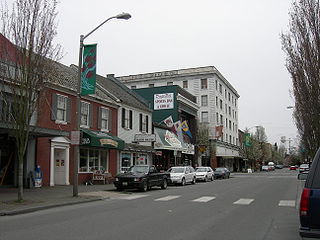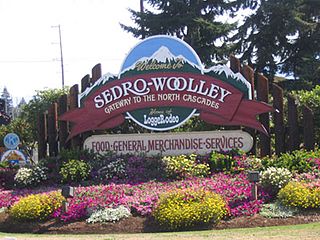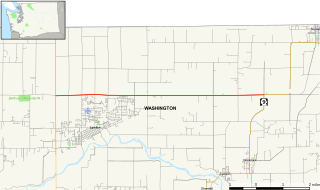
Whatcom County is a county located in the northwestern corner of the U.S. state of Washington, bordered by the Canadian Lower Mainland to the north, the Okanogan County to the east, the Skagit County and San Juan County to the south and southwest, and the Salish Sea to the west. Its county seat and largest population center is the coastal city of Bellingham, comprising the Bellingham, WA Metropolitan Statistical Area, and as of the 2020 census, the county's population was 226,847.

Mount Vernon is the county seat of Skagit County, Washington, United States. The population was 35,219 at the 2020 census. It is one of two principal cities of and included in the Mount Vernon-Anacortes, Washington Metropolitan Statistical Area. Downtown Mount Vernon is known for its annual Tulip Festival Street Fair, which is part of the Skagit Valley Tulip Festival. The climate of Skagit County is similar to that of Northern France, with millions of tulips grown in the Skagit Valley. In 1998, Mount Vernon was rated the #1 "Best City in America" by the New Rating Guide to Life in America's Small Cities.

Sedro-Woolley is a city in Skagit County, Washington, United States. It is part of the Mount Vernon–Anacortes, Washington Metropolitan Statistical Area and had a population of 10,540 at the 2010 census. The city is home to North Cascades National Park.

Fairhaven was a settlement in Washington state founded in 1883 by Dan Harris. In 1903, it became part of the city of Bellingham.

The Seattle and Walla Walla Railroad was a 3 ft narrow gauge railroad and was the first proper railroad to serve Seattle, Washington, preceded only by horse-drawn rail vehicles and by a coal train making the very short haul from Lake Union to Pike Street. Despite its ambitious name, actual construction never went beyond King County, the county of which Seattle itself is the seat. After being sold to Henry Villard's Oregon Improvement Company in 1880 it was renamed the Columbia and Puget Sound Railroad. In 1916, that became the Pacific Coast Railroad Company.
The Seattle, Lake Shore and Eastern Railway (SLS&E) was a railroad founded in Seattle, Washington, on April 28, 1885, with three tiers of purposes: Build and run the initial line to the town of Ballard, bring immediate results and returns to investors; exploit resources east in the valleys, foothills, Cascade Range, and Eastern Washington in 19th-century style, attracting more venture capital; and boost a link to a transcontinental railroad for Seattle, the ultimate prize for incorporation. The historical accomplishment of the line was Seattle to Sumas at the border, with British Columbia, Canada, connecting with the Canadian Pacific transcontinental at the border at Huntingdon, British Columbia, now part of the City of Abbotsford.
State Route 9 (SR 9) is a 98.17-mile (157.99 km) long state highway traversing three counties, Snohomish, Skagit, and Whatcom, in the U.S. state of Washington. The highway extends north from an interchange with SR 522 in the vicinity of Woodinville north through Snohomish, Lake Stevens, Arlington, Sedro-Woolley, and Nooksack to become British Columbia Highway 11 (BC 11) at the Canada–US border in Sumas. Three other roadways are briefly concurrent with the route: SR 530 in Arlington, SR 20 in Sedro-Woolley, and SR 542 near Deming. A spur route in Sumas serves trucks traveling into British Columbia.
State Route 11 (SR 11) is a 21.28-mile (34.25 km) long state highway that serves Skagit and Whatcom counties in the U.S. state of Washington. SR 11, known as Chuckanut Drive, begins at an interchange with Interstate 5 (I-5) north of Burlington and continues northwest through several small towns and the Chuckanut Mountains to the Fairhaven district of Bellingham, where the highway turns east and ends again at I-5.

Charles Xavier Larrabee was an American businessman and a co-founder of the town of Fairhaven, Washington. Later in life, Larrabee and his wife Frances donated much land for civic purposes, including schools and parks, and were considered stewards of the city of Bellingham.

State Route 546 (SR 546) is a state highway in Whatcom County, Washington, United States. It runs east–west for 8 miles (13 km) near the Canadian border, connecting SR 539 near Lynden to SR 9 near Nooksack and Sumas. The highway is a major freight corridor and serves as an alternate route between Bellingham and the Sumas border crossing.
The history of Bellingham, Washington, as it is now known, begins with the settling of Whatcom County in the mid-to-late 19th century.

The Pacific Northwest Corridor or the Pacific Northwest Rail Corridor (PNWRC) is one of eleven federally designated higher-speed rail corridors in the United States. The 466-mile (750 km) corridor extends from Eugene, Oregon to Vancouver, British Columbia via Portland, Oregon and Seattle, Washington in the Pacific Northwest region. It was designated a high-speed rail corridor on October 20, 1992, as the fifth of five corridors called for in the Intermodal Surface Transportation Efficiency Act of 1991 (ISTEA) although it is now called a higher-speed rail since the minimum speed for a high speed rail is designated as 125 miles per hour (201 km/h). The corridor is owned by BNSF Railway in Washington and British Columbia, and by Union Pacific Railroad (UP) in Oregon, and is used by a mix of freight and passenger trains operated by BNSF, UP, and Amtrak. If improvements to the corridor are completed as proposed in Washington State's long range plan, passenger trains operating at a maximum speed of 110 miles per hour (180 km/h) would travel between Portland and Seattle, in 2 hours and 30 minutes, and between Seattle and Vancouver in 2 hours and 37 minutes by 2023.
The Puget Sound Shore Railroad and successor Northern Pacific and Puget Sound Shore Railroad built a branch line of the Northern Pacific Railroad between Puyallup and Seattle, Washington, U.S., and partially constructed a line around the east side of Lake Washington to Woodinville.
U.S. Bicycle Route 87 is a U.S. Numbered Bicycle Route in Washington and Alaska in the United States, that is planned to extend south along the West Coast to California. As of 2017, the segments in northern Washington and southeastern Alaska have been added to the system, running a total of 87 miles (140 km).
Philip Woolley was a Canadian American businessman for whom the city of Sedro-Woolley, Washington, is partly named.

Daniel Jefferson "Dirty Dan" Harris was an early settler of the Bellingham Bay area and founder of the town of Fairhaven, Washington. Following a stint as a whaler in the Pacific Ocean, Harris arrived in Washington Territory in either 1853 or 1854. After years of trading and buying land surrounding his original homestead, he platted the property into the town of Fairhaven in 1883 and began selling plots for gold. By 1889, Harris sold off his remaining land to Nelson Bennett and C. X. Larrabee for US$75,000. Bennett and Larrabee continued to develop Fairhaven until its incorporation with other Bellingham Bay towns into the city of Bellingham in 1903. Harris retired to Los Angeles where he died in 1890. Residents of Bellingham today celebrate an annual festival in Harris's honor where visitors can learn about the early history of the city.

Nelson Bennett was a Canadian-American railroad magnate who contributed to the growth of Fairhaven and Tacoma, Washington in the late 19th-century. Bennett was president of the Fairhaven and Southern Railroad, which first connected the Bellingham Bay region with the rest of the country.

The Interurban Trail is a rail trail in Whatcom County, Washington. It runs 6.6 miles (10.6 km) between Fairhaven and Larrabee State Park (48°38′52″N122°29′12″W) in the Bellingham area. Popular with hikers and bicycles, the trail runs parallel to Chuckanut Drive through the Chuckanut Mountains. The trail follows the shoreline of the Salish Sea and Puget Sound, with ample views of Bellingham Bay, the Lummi Peninsula, Portage Island, Lummi Island, Chuckanut Bay and the distant San Juan Islands.
The Bellingham Subdivision or Bellingham Sub is a railway line running about 119 miles (191 km) from Everett, Washington to Blaine, Washington. It is operated by BNSF Railway.

John Joseph Donovan was a Washington State pioneer and the president of the state Chamber of Commerce, as well as one of the key founders of the City Council of Bellingham, Washington. During his life, Donovan actively participated in political, industrial, and commercial activity on city, county, and state levels. Several historic landmarks exist in Bellingham honoring J. J. Donovan, including his house, which was added to the National Historic Register, and a bronze statue installed in Fairhaven, Washington.












